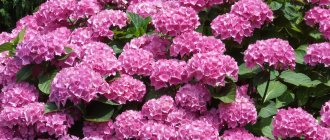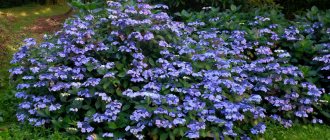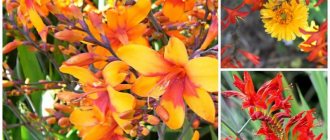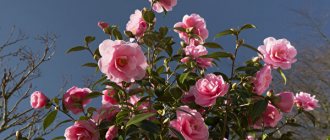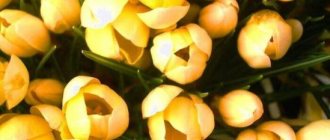Gardeners who want to decorate their garden with beautiful flowering shrubs always pay attention to a plant such as Hydrangea. But when wondering which variety to choose for planting in their garden, they are faced with a huge variety of varieties of this ornamental crop. In this article we want to introduce you to one of the most popular varieties - Hydrangea paniculata Wim's Red. We will tell you in detail how to grow this variety in open ground.
History of selection
The hydrangea flower was first brought to Europe from China in the 18th century, and after 2 centuries the widespread popularization of this plant began. Soon, the variety of varieties and hybrid forms of hydrangea exceeded 100 varieties and subspecies, differing in height, bud size and degree of resistance to adverse weather conditions.
The Weems Red hydrangea variety was developed not so long ago. Its originator is the German breeder Wim Rutten. The main difference between the flower and others is the very early flowering time - the Weems Red hydrangea blooms earlier than all other types and varieties of hydrangeas.
Landscape: use in decorating gardens, flower beds
This colorful shrub looks great both in a group and when growing a single plant. It is often used to create contrasting flower beds. It looks great surrounded by conifers and other evergreen shrubs.
With the help of Wims Red hydrangea you can decorate a hedge or alley to your house. This use of the plant will allow you to create a beautiful landscape accent and fill the air around with a subtle aroma with notes of honey.
Despite the care requirements, paniculate hydrangea is available for planting in private areas. If you follow the rules of care, it will reward you with long, lush and incredibly beautiful flowering.
Description of paniculata hydrangea Weems Red
Hydrangea paniculata Wim's Red is a dense, fairly compact deciduous shrub, characterized by long and abundant flowering, which lasts from July to September, and even until October in regions with warm climates.
The average height of adult plants is 1.5-2 m. The shoots of Weems Red hydrangea are moderately rigid and weakly branched. The skin on the shoots is brown-red. Under the weight of large inflorescences, some branches of the hydrangea can bend, due to which the appearance of the bush begins to resemble a ball.
The leaves of Hydrangea paniculata are dense, ovate, dark green with pronounced veins. On the shoots they are located opposite. The inflorescences externally resemble tall, elongated pyramids. The length of the inflorescences varies from 20 to 35 cm.
As they bloom, hydrangea buds change color: at first they are white, but soon acquire a pinkish tint. Then this color smoothly flows into a rich burgundy tone.
The aroma of the Weems Red variety is pleasant, of medium intensity. Many gardeners note in their reviews that it contains pronounced honey notes.
A flowering bush of Hydrangea paniculata variety Weems Red is shown in the photo below.
Winter hardiness of hydrangea Weems Red
The resistance of Weems Red hydrangea to low temperatures, according to the description of this variety, is quite high. The plant tolerates frosts down to -30°C without any negative consequences.
Resistance to diseases and pests
The plant's resistance to diseases is average. The greatest threat to Weems Red hydrangea is from the following diseases:
- chlorosis;
- powdery mildew;
- anthracnose
Plants can also be affected by the following pests:
- spider mite;
- aphid;
- Colorado beetle.
Diseases and pests
The most common disease of paniculate hydrangea is chlorosis. Most often occurs on alkaline soils. To return color to the leaves, iron chelate is used for foliar feeding. Use the drug once a week. To prevent this disease, you can bury iron objects - nails, horseshoes - into the hole near the plant.
When affected by white rot, the bush turns brown and signs of decay appear. The leaves are covered with a “web”. Phytosporin is used to treat this disease.
The appearance of yellow-green spots on the leaves indicates powdery mildew. Over time, the damaged areas become brown.
On a note! If such a sheet is turned over, the reverse side will have a metallic tint.
If there are no buds on the bush, and uneven, vague ring-shaped spots appear on the leaves, the plant is suffering from hydrangea ring spot. This disease has no cure. The plant is destroyed.
Does not bypass hydrangea and aphids. It can be detected by the curled apical leaves. If you unfold such a leaf, aphids will sit on the back side. Some gardeners recommend washing it off with soapy water and a sponge. But it will be much more effective to treat the plant with an insecticide.
Untreated plants may suffer from anthracnose, spider mites, and Colorado potato beetles. In order not to think about what exactly affected the plant, they carry out preventive treatment of the bushes with fungicides such as Skor, Maxim, Horus, Aktara.
Methods for propagating hydrangea
Hydrangea paniculata varieties Weems Red are propagated in different ways. You can do this:
- seeds;
- layering;
- cuttings.
This flower is practically not propagated by seeds, since this method has many disadvantages. Hydrangea seeds have low germination, and growing full-fledged seedlings is time-consuming.
Cuttings for propagating hydrangeas are taken as annuals. Old shoots do not take root well. The algorithm for preparing cuttings is as follows:
- The bush is cut at the bottom, immediately after the bud. The total length of the cutting should be 15-18 cm and contain at least 3 internodes.
- Cut cuttings are immersed in water for 3 days.
- For better development of hydrangea, it is recommended to treat the lower cut of the cutting with any growth stimulant.
- After the specified time, the cuttings are planted in a container with a pre-prepared peat mixture. The cuts are deepened by 2/3 of the total length.
- After planting the cuttings, the soil is moistened daily.
- In spring, planting material is planted in open ground.
As a rule, preparation of cuttings begins in late June and is completed by autumn.
The procedure for propagation by layering includes the following steps:
- In spring or late summer, one of the lower shoots of the hydrangea is bent towards the ground and attached to the ground with a metal bracket.
- Then the place of contact with the soil is cut and slightly deepened. It is important that the end of the shoot is in a vertical position.
- Next year the cuttings should take root. Then it is carefully separated from the bush and moved to a new place.
With this method of propagation, hydrangea blooms the very next year after planting.
Conditions for keeping
To successfully grow Hydrangea paniculata "Weems Red" it is important to provide it with:
- Optimal soil composition;
- Necessary lighting;
- Humidity.
This variety is very critical to the composition of the soil. It grows well in acidic and slightly acidic soils. It also tolerates soils with neutral acidity, but the color of the flowers in this case will be much paler. Alkaline soils are harmful to plants. When planted in soil with an alkaline reaction, the shrub stops growing, does not bloom, and soon dies. Hydrangea should not be planted in places where lime has been added to the soil, as this substance also makes the soil alkaline.
Planting and caring for paniculate hydrangea Weems Red
According to the description of the Weems Red hydrangea variety, planting and subsequent care of the flower will not be difficult. If the planting dates and site requirements for planting are met, there will be no problems with growing these flowers.
Recommended timing
Hydrangea of this variety can be planted both in autumn and spring. Each time has its advantages depending on the planting region.
In the Northern regions, when planted in spring, the chances of the plant to take root are somewhat higher than when planted in the fall. In temperate and warm climates, it is better to plant hydrangea in the fall, since after hardening by the winter cold, the plants develop more actively in the spring.
The soil for flowers is prepared in advance. 15-20 days before planting the seedlings, the area is dug up and fertilized with a mixture of peat, sand, leaves and turf soil.
Choosing a suitable location
Hydrangea paniculata develops best in conditions of high humidity, since its root system is not sufficiently developed and cannot independently take moisture from the lower layers of the soil. That is why it is better to give preference to shaded areas, although with frequent watering the flower grows well in the sun.
It is also important to provide flowers with protection from strong winds. It is better to plant bushes in areas provided with reliable barriers on the north side.
Despite the fact that hydrangea is considered an unpretentious plant, for the best development of the flower it is recommended to pay attention to the type of soil of the potential planting site. They usually focus on loose fertile soils with neutral or high acidity.
Important! Depending on the acidity level of the soil, the color of hydrangea buds varies greatly. Rich colors can be obtained by growing flowers in acidic soils.
This variety should absolutely not be planted on sandy soils or soils with a high lime content. However, if necessary, the acidity of the soil can be adjusted: to do this, the area is dug up and fertilized with fresh manure or sulfur sulfate. You can also use colloidal sulfur.
Selection and preparation of planting material
When choosing seeds for planting directly into the ground, you should pay attention to the age of the planting material. Old seeds have poor germination.
When choosing seedlings, the recommendations are the same as for many other garden crops. There should be no stains or plaques on the surface of the plants, as well as mechanical damage, since small wounds can easily infect the crop with a fungus or other infection.
Landing algorithm
Planting hydrangea varieties Weems Red is carried out according to the following plan:
- In the prepared area, planting holes are dug 40 cm deep. The diameter of the holes is at least 50 cm. The recommended distance between two adjacent holes is 90-100 cm.
- The fertile top layer of soil from the site is poured into the bottom of the planting hole. The layer thickness should be about 10-12 cm.
- In the center of the hole, a small hill resembling a hill is formed from this earth.
- The seedling is lowered onto this hill so that its roots are evenly distributed over the surface of the fertile soil. After deepening the plant, the root collar should remain above ground level.
- After the seedling is covered with soil, the soil is lightly compacted.
- Planting is completed with abundant watering.
Advice! For better moisture retention, you can mulch the flower’s trunk circle with straw or peat.
Additionally, the process of planting hydrangeas is described in the following video:
Choosing a landing site
Since Wims Red loves both moisture and warmth, it should be planted in shaded areas with moderate sunlight. This will allow the plant to fully develop even with infrequent watering.
Popular articles 8 best varieties of large-flowered clematis
In sunny vacant lots and in the shade, the hydrangea root system does not grow to its full potential. As a result, the shrub is characterized by weak foliage and a lack of flowers. Even increased watering may not give the desired effect. If the conditions for planting hydrangea are met, it is accepted quickly.
Hydrangea is the “queen” of the garden. No other flowering plants are planted within the circumference of this deciduous shrub at a distance of one and a half meters. With its large inflorescences, hydrangea shades the area and prevents them from growing fully, whereas, given a favorable location, it can grow for up to 60 years.During the spring-summer period, the root system of the flower bush requires feeding with organic and mineral fertilizers. Due to poor-quality soil fertilization, the plant may suffer from chlorosis and powdery mildew. The first feeding of the plant with nutrients is carried out at the time of planting.
For the growth and development of the root system of hydrangea variety paniculata Wim's Red, the soil should be carefully prepared:
- moisten;
- loosen;
- mix it with humus and peat;
- enrich with superphosphate, urea and potassium sulfate.
Fertilizers are applied to the soil on the second day after preparing the excavation (40 cm deep, 50 cm wide, 50 cm long) for planting the plant and moistening it. In order for the soil to be saturated with moisture, three buckets of water are poured into the dug hole under the hydrangea seedling and allowed to be completely absorbed. Subsequent feeding after planting the shrub should be done several times a season.
It is imperative to fertilize the soil under the plant before flowering begins and after it ends.
This is done like this:
- In March, hydrangeas should be provided with favorable conditions for the formation of elastic shoots and lush foliage - enrich the soil with nitrogen. Urea and potassium sulfate are dissolved in water in the proportions of 10 l.*1 tbsp. * 1 tbsp. l. Consumption per adult bush is 5 liters of mixture. The bushes are also watered with slurry diluted with water in a ratio of 1:10.
- Before flowering, the bush is fertilized with phosphorus and potassium. Superphosphate is diluted in water in a proportion of 1 tbsp. l. *10l. Consumption per adult bush is 2 liters. You also need to periodically spray and water the plant with a weak solution of potassium permanganate.
- To increase the number of buds, hydrangea is fertilized in June with granular mixtures of “Agricol” and “Nitrophoska”. In 10 liters of water, dilute 1 tbsp. spoon of fertilizer and water the bushes with the mixture.
- In July, for stable and long-lasting flowering of hydrangea, complex fertilizers “Fertika” are applied to the soil.
- To prepare the shrub for wintering, at the end of August the soil is fertilized with organic fertilizers - slurry. At the end of September, the application of phosphorus and potassium is repeated.
The Wim's Red variety is a hydrangea recently bred by domestic breeders. It is protected from most pests that attack garden plants. However, during the hot season, a colony of spider mites can multiply on hydrangea bushes. The fight against it involves the use of fungicides.
Caring for Weems Red hydrangea
Hydrangea Weems Red is quite resistant to most diseases and tolerates low temperatures well. If we add to this the undemanding nature of the light level, then caring for the flower comes down to only regular watering (since the plant is moisture-loving), optional fertilizing and pruning.
Watering
The frequency of watering depends on the prevailing weather. During frequent rains, plants are practically not watered. On hot days, the norm is up to 30 buckets of water per 1 m2. The top layer of soil near the bush should always be slightly moist.
Important! To water Hydrangea paniculata variety Weems Red, use only settled water.
Top dressing
The plantings are fed with potassium or ammonium sulfate, but only until mid-July. In August, superphosphate is already used.
The Weems Red variety also responds well to fertilizing with organic fertilizers. Whey, which acidifies the soil, has proven itself especially well. This fertilizing promotes abundant flowering and growth of green mass.
Mulching and loosening the soil
Immediately after planting, it is necessary to shallowly loosen the flower’s trunk circle and mulch it with sawdust. This is necessary in order to create a moderately humid microclimate near the root system of the plant.
Trimming
Weems Red hydrangeas are pruned annually, however, young plants do not require this procedure. The shoots begin to be pruned when the bush is three years old. This is necessary in order to improve flowering and rejuvenate the plant as a whole.
Pruning is done in March, before the first buds appear, or in the fall, when the bushes have completely shed their foliage. Cut cuttings take root well in the soil, so cut shoots are often used for flower propagation.
Preparing for winter
Preparatory procedures for wintering come down to sanitary pruning of paniculata hydrangea. It involves removing dry and broken shoots, as well as cutting off dried inflorescences. This is done because in winter snow may accumulate on them, which will result in the branches breaking under the weight of precipitation.
Sheltering shrubs for the winter
Adult plants in central Russia do not need to be covered for the winter - paniculate hydrangea is a frost-resistant garden crop. With the onset of cold weather, it is recommended to cover young seedlings and flowers grown in the Northern regions with foliage, burlap or spruce branches.
Diseases and pests, methods of control and prevention
Most often, hydrangea paniculata variety Weems Red suffers from chlorosis. Prevention of the disease consists of feeding plants with a solution of salts with a high iron content. Watering frequency – once every 15 days. If the flowers are still sick, then they need to be fed with iron chelate, after which the paniculata hydrangea will quickly recover.
Any fungicide can be used against fungal diseases. The insecticide "Aktara" effectively controls pests.
Fertilizer
During the spring-summer period, the root system of the flower bush requires feeding with organic and mineral fertilizers. Due to poor-quality soil fertilization, the plant may suffer from chlorosis and powdery mildew. The first feeding of the plant with nutrients is carried out at the time of planting.
For the growth and development of the root system of hydrangea variety paniculata Wim's Red, the soil should be carefully prepared:
- moisten;
- loosen;
- mix it with humus and peat;
- enrich with superphosphate, urea and potassium sulfate.
Fertilizers are applied to the soil on the second day after preparing the excavation (40 cm deep, 50 cm wide, 50 cm long) for planting the plant and moistening it. In order for the soil to be saturated with moisture, three buckets of water are poured into the dug hole under the hydrangea seedling and allowed to be completely absorbed. Subsequent feeding after planting the shrub should be done several times a season.
It is imperative to fertilize the soil under the plant before flowering begins and after it ends.
This is done like this:
- In March, hydrangeas should be provided with favorable conditions for the formation of elastic shoots and lush foliage - enrich the soil with nitrogen. Urea and potassium sulfate are dissolved in water in the proportions of 10 l.*1 tbsp. * 1 tbsp. l. Consumption per adult bush is 5 liters of mixture. The bushes are also watered with slurry diluted with water in a ratio of 1:10.
- Before flowering, the bush is fertilized with phosphorus and potassium. Superphosphate is diluted in water in a proportion of 1 tbsp. l. *10l. Consumption per adult bush is 2 liters. You also need to periodically spray and water the plant with a weak solution of potassium permanganate.
- To increase the number of buds, hydrangea is fertilized in June with granular mixtures of Agricoli Nitrophoska, diluting 1 tbsp in 10 liters of water. spoon of fertilizer and water the bushes with the mixture.
- In July, for stable and long-lasting flowering of hydrangea, Fertik complex fertilizers are applied to the soil
- To prepare the shrub for wintering, at the end of August the soil is fertilized with organic fertilizers - slurry. At the end of September, the application of phosphorus and potassium is repeated.
The Wim's Red variety is a hydrangea recently bred by domestic breeders. It is protected from most pests that attack garden plants. However, during the hot season, a colony of spider mites can multiply on hydrangea bushes. The fight against it involves the use of fungicides.
A little historical background
Large-leaved hydrangea was the first to appear in Europe. This happened at the very end of the 18th century. It was brought by French travelers from the island of Mauritius, located in the Indian Ocean. Prince of the Roman Empire K.G. was also a participant in this first round-the-world expedition for the French. Nassau-Siegen. It is believed that he named the beautiful plant in honor of his beloved sister.
Large-leaved hydrangea was born on the island of Mauritius and appeared in Europe thanks to the first French expedition around the world. It’s impossible not to notice such a beauty even in the luxurious governor’s garden
However, other sources claim that the shrub received its name in honor of the beloved of the French doctor F. Commerson. There is also a less romantic version of the appearance of this name: the bush was discovered in the governor’s garden. So they named it in honor of this event in Latin hortensis, which means “from the garden.”
Otherwise, this moisture-loving bush is called hydrantia. Translated from Greek, hydor means “water”, and angeion means “vessel”. Moreover, the point was not only that the bush needs frequent watering, but also that its seed pods look like a vessel - a jug. But the more pleasing name to the ear gradually prevailed over the Latin.
Trimming
Bush pruning is also required during preparation for winter. In this case, the gardener’s goal is to rejuvenate the shrub, so old, damaged shoots are removed. They are cut so that stumps 5-6 cm long remain.
To make your hydrangea bloom brighter, in the spring, before the growing season begins, you need to carry out proper pruning. In addition, this procedure will give the plant a neat, regular shape during the flowering and growth period. In the spring, select five to ten strong and healthy shoots on each bush. Reduce their length so that no more than five buds remain.
